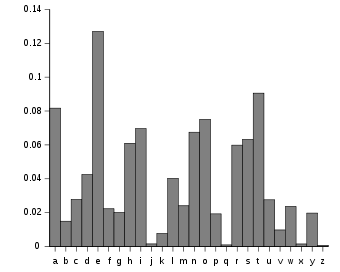
Back تحليل التكرار Arabic Anàlisi de freqüències Catalan Frekvenční analýza Czech Häufigkeitsanalyse German Ανάλυση συχνότητας γλώσσας Greek Análisis de frecuencias Spanish تحلیل فراوانی Persian Frekvenssianalyysi Finnish Analyse fréquentielle French ניתוח תדירויות HE

In cryptanalysis, frequency analysis (also known as counting letters) is the study of the frequency of letters or groups of letters in a ciphertext. The method is used as an aid to breaking classical ciphers.
Frequency analysis is based on the fact that, in any given stretch of written language, certain letters and combinations of letters occur with varying frequencies. Moreover, there is a characteristic distribution of letters that is roughly the same for almost all samples of that language. For instance, given a section of English language, E, T, A and O are the most common, while Z, Q, X and J are rare. Likewise, TH, ER, ON, and AN are the most common pairs of letters (termed bigrams or digraphs), and SS, EE, TT, and FF are the most common repeats.[1] The nonsense phrase "ETAOIN SHRDLU" represents the 12 most frequent letters in typical English language text.
In some ciphers, such properties of the natural language plaintext are preserved in the ciphertext, and these patterns have the potential to be exploited in a ciphertext-only attack.
- ^ Singh, Simon. "The Black Chamber: Hints and Tips". Retrieved 26 October 2010.
© MMXXIII Rich X Search. We shall prevail. All rights reserved. Rich X Search